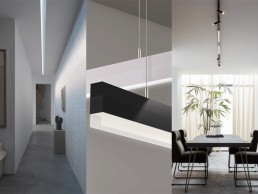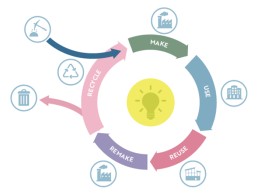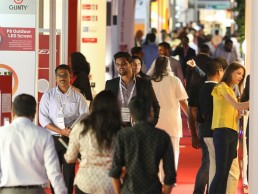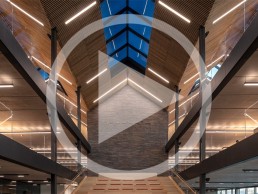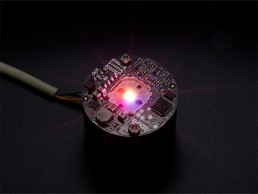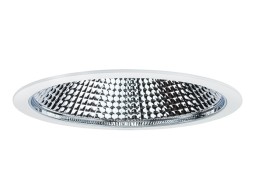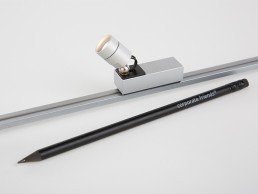Architect@Work to return to London this April
(UK) – Architect@Work will be making its return to The Truman Brewery, London, from 13-14 April.
Showcasing more than 70 international brands across multiple sectors, the show has a whole host of new product launches for visitors to explore this year, making it the go-to event for architects, designers and specifiers.
Lighting continues to have a strong presence at Architect@Work, with a selection of Italian lighting manufacturers partaking in the show. CoeLux, which specialises in an optical system based on nano technology to artificially reproduce the natural light and visual appearance of the sun and sky, will bring its Sky Line series to the event.
Auralis will launch Filo Flex, a new range of flexible, architectural lighting fixtures for both the exterior and interior, offering a continuous light – either in straight lines or in sharp bends – to emphasise all the possible shapes. Meanwhile, Florence-based Targetti will present 3F Solo. Conceived by 3F Filippi’s optical laboratory, 3F Solo enables the light to diffuse into a space in a soft, non-blinding way. Its complex shape with horizontal grooves create a symmetry that makes the body of the luminaire lighter when switched on.
This year’s Architect@Work also sees exhibitors joining from Belgium. Bega will demo its Architectural Lighting Management System (ALMS), Bega Connect. Expanding the possibilities of professional light control, Bega Connect allows its users to control, plan and monitor individual luminaires from any location via an intuitive app.
Also from Belgium is Wever & Ducré, which will bring Strex to the event. A 48-volt track system, Strex combines spotlights, pendulums, opal insets and multi-dot insets, while clicking into place anywhere on the profile without tools. This latest innovation uses LED track lighting and pendant lights to avoid bulky converter housings.
German manufacturer TTC will showcase its LED-Lightline 40.30, powered by ADO-Lights. The lightline can be integrated in façades and floor spaces, with customisable length, height and light output. Suitable for outdoor use, it can be walkable and drivable. With the use of LED boards instead of LED strips, it also offers a high lumen output without the glare.
Also present at Architect@Work will be Austrian company, XAL. Its rope-like, highly flexible LED luminaire, Jane is made of food-safe silicone and can be arranged into custom patterns with ceiling clips and cable holders. With a homogeneous light distribution, and a diameter of only 18m, it can be installed in both small and large projects.
Other lighting exhibitors at the event include Linea Light, Penta, Lightnet, Landa and Lodes.
Planning underway for Light + Building 2022
(Germany) – With the new target firmly in sight, planning for the Light + Building Autumn Edition from 2 to 6 October 2022 is in full swing.
More than 1,300 exhibitors from 46 countries are already lined up in autumn for the restart of the lighting and building technology sector in Frankfurt am Main.
“In the last few weeks, we have contacted all exhibitors at Light + Building and talked about the possibilities for the new date. Many important national and international industry players have confirmed their participation. The Building side is very well positioned again and leading manufacturers from the safety and security sector complete the range. We had to restructure the exhibitors from the lighting sector because the availability of halls here is different in autumn than at the original date in March. Despite the unusual timing for innovation presentations, many lighting exhibitors are committed to Light + Building as a meeting place for the sector and ensure an attractive, diverse and international lighting sector,” explains Iris Jeglitza-Moshage, Senior Vice President Technology.
The manufacturers of the lighting and building technology sector jointly decided on the date in autumn. “We are currently hearing again and again from exhibitors and visitors that the date for the personal meeting is still needed this year. We are confident that the 2022 event will be a good bridge to get back to a much-needed and normal trade fair schedule,” Jeglitza-Moshage continues.
In 2024, Light + Building will once again take place in its usual slot in March.
At Light + Building Autumn Edition, visitors can expect a broad overview and insight into the industry: All electricity-carrying trades will be represented. So far, in lighting and luminaire design, AEC, Artemide, Bega, Casambi, Ledvance, Linea Light, Molto Luce, Nichia and Samsung will be present. In addition to a large number of Italian exhibitors, the other top exhibitor countries include Turkey, Spain, Poland, the Netherlands, Great Britain, Belgium, Greece, France and Austria.
Exhibitors in Hall 8.0 will be showing innovations in areas of safety, efficiency, light sources and control, as well as lighting components. Halls three, four, six and 10 are devoted entirely to lighting, with a unique range of products including designer luminaires in all styles, technical luminaires, outdoor and street lighting as well as emergency and safety lighting. There is a promotion area of the Federal Ministry for Economic Affairs and Climate Action for young companies in the decorative luminaires product area on the East Area.
With the start of the event, this will then be expanded into the Light + Building Digital Extension. Parallel to the physical trade fair in Frankfurt, the digital platform will offer, from 2 to 14 October 2022, new opportunities for networking, knowledge exchange and encounters. The additional offer helps to expand one’s own circle of contacts in a targeted manner via AI-supported match-making. The platform also provides more independence from time and place: Exhibitors can hold product presentations via video streaming, get in touch with customers digitally and all participants have the opportunity to find out about the Light + Building programme items on-demand following the live event.
The Light + Building event will take place from 2 to 6 October 2022. The Intersec Forum will open in parallel from 3 to 6 October 2022. The Light + Building Digital Extension is accessible from 2 to 14 October 2022.
Nuckolls Fund distributes $130,500 in Grants and Awards for 2022
(USA) – The Nuckolls Fund for Lighting Education for 2022 has issued grants and awards totalling $130,500, ranging from $5,000 to $30,000.
Due to Covid restrictions, a presentation planned for LEDucation in New York City was replaced by mail notifications. This year’s grants and awards brought the Fund’s total distribution to $1,715,500 since its formation in 1988.
The Nuckolls Fund supports college-level lighting programmes that enable students to learn, appreciate and apply the fundamentals of lighting design, and to recognise the achievements of the late lighting designer and educator, James L. Nuckolls. Submittals for financial support from the Fund’s programmes are judged annually by its Board of Directors.
This year, three $30,000 Nuckolls Grants are being applied to expanding lighting curricula. This includes funding an upper-level advanced lighting course for interior designers at the University of Arkansas, Fayetteville, by Jake Tucci; a new course in the School of Architecture and Design at Virginia Tech incorporating the 14 Patterns of Biophilic Design, by James Jones and Ron Gibbons; and a continuation of new lighting related curricula at Mississippi State University, by Robin Carroll.
In addition, Victoria McReynolds at Texas Tech was the recipient of the $7,500 Lesley Wheel Grant to initiate the acquisition of testing and building lighting tools as a basis for an architectural lighting course to monitor the Llano Estacado natural setting and its measurable effects on human wellness with energy sustainability. The $13,000 Edison Price Fellowship will be applied to the summer internship of Arpan Guhan at the Light and Health Research Center at Lawrence Technological University.
Four Student Achievement awards of $5,000 were distributed to Sachintha De Van Gunawardena, Renesselaer Polytechnique Institute, for the Jonas Bellovin Scholar Achievement Award; Wangyang Song, Pennsylvania State University, for the Jules Horton International Student Achievement Award; and Makayla Thomposon, University of Nebraska/Lincoln and Paola Kwan, University of Colorado/Boulder for the 2021 Designers Lighting Forum of New York Student Achievement Awards.
Nuckolls Fund President Lee Waldron, President of Grenald Waldron Associates, praised each of the recipients, and recognised the generosity of the lighting community: “We are proud of our record to continue financial support for the advancement of lighting education. In total, 140 grants and awards have been sponsored by the Nuckolls Fund during its 33 years, including 59 grants to expand or create a new lighting course.”
The Lighting Practice launches Dallas office
(USA) - The Lighting Practice has opened offices in a third location, with the formation of a Dallas-based studio.
Led by Principal Jered Widmer, the Dallas office will accommodate the firm’s rapid growth, while serving as a home base for local and national projects.
“It’s an exciting new chapter for The Lighting Practice to expand our physical presence in Texas,” said Widmer. “I am looking forward to being local to many of our current projects and clients.”
Helen Diemer, President of The Lighting Practice, added: “We’ve had the good fortune to be able to build and grow strong relationships with great clients in Texas over the years. With Jered’s leadership in Dallas, we are pleased to be able to expand our base of operation and offer our Texas and southern regional clients access to more in-person consultation and design services.”
The Dallas market, and Texas as a whole, is not unchartered territory for The Lighting Practice. The firm has been part of Texas design teams, working on impactful projects for several years, inlacing: Liberty Mutual Headquarters, ICR Discovery Center, Austin Ridge Bible Church, Le Meridien Houston, Blue Flame El Paso, UTSW William P. Clemente Jr. University Hospital and The American Airlines Admirals Club at DFW Airport (pictured).
In addition to opening its Texas office location, The Lighting Practice is a certified Women-owned Business Enterprise (WBE) through the Texas Women’s Business Enterprise Alliance and WBENC Women’s Business Council - Southwest.
CIBSE and LIA set up new Circular Economy Assurance Scheme
(UK) – The Chartered Institution of Building Services Engineers (CIBSE) and the Lighting Industry Association (LIA) have together launched a new circular economy assurance scheme designed to support the accuracy of circular economy claims from lighting manufacturers and specifiers. The TM66 Circular Economy Assured scheme will provide a quality mark for the design and manufacture of lighting products.
Supporting the recently published TM66 Creating a circular economy in the lighting industry and accompanying Circular Economy Assessment Methods (CEAM), the scheme forms part of this toolkit for manufacturers and specifiers to assess the circular economy credentials of products.
Published in 2021, the award-winning TM66 Creating a circular economy in the lighting industry is the result of cross-industry collaboration, providing practical guidance and tools to enable the sector to deliver a circular, sustainable approach to lighting and building services engineering more broadly.
Major specifiers and organisations have already adopted this metric and the intention is to develop it beyond lighting products, for application in other areas of building services engineering. Manufacturers are already rating their luminaires, while others are seeking assistance to do so with a shared ambition to ensure credibility, objectivity, and consistency in their ratings.
David Barnwell, Managing Director of Holophane Europe Ltd. commented: “Anything that helps to drive greater knowledge of the environmental benefits of a circular economy approach is a positive step forwards and being able to specify a minimum rating in line with industry accepted guidance strengthens the delivery of sustainable lighting through the supply chain. The TM66 Circular Economy Assured scheme provides participating manufacturers with a way to demonstrate their sustainability and provides a clear differentiation from unsubstantiated greenwash.”
This scheme combines CIBSE’s deep sustainability knowledge and UKAS accredited certification expertise with the LIA’s Quality Assurance systems and independent UKAS accredited laboratory.
Society of Light and Lighting President Ruth Kelly Waskett said: “Sustainability is at the heart of good lighting practice, but our focus is now shifting from energy efficiency in use towards whole life carbon and the life cycle of materials. TM66 and CEAM have already given us a framework within which to evaluate products and equip us to make the right specification decisions. TM66 Circular Economy Assured takes us one step further, giving us the added benefit of knowing that circular economy claims are robust and comparable between products. This allows decisions to be made at the specification stage and then protected through any value engineering process.”
Terry Dean, LIA President added: “The lighting industry has long been a key solution to delivering net zero, but many recognise that we will soon be asked to prove and improve all aspects of our environmental impact. Moving away from the unsustainable linear economy of take, make, waste, to a circular economy where we conserve, value and extend the life of the resources in our luminaires is the next step. We are delighted to build this partnership with CIBSE, led by Bob Bohannon, the LIA’s Head of Policy and Academy who was TM66 and CEAM’s lead author. It brings our two organisation’s key strengths together to deliver this much asked for level playing field in sustainability ratings.”
www.cibse.org
www.thelia.org.uk
Light Middle East rescheduled to early 2023
(UAE) – Organisers of Light Middle East have announced new show dates for the upcoming instalment of the event, as well as the launch of the brand new Intelligent Building Middle East as part of the show.
Originally scheduled for 15-17 November, the event will now take place on 17-19 January 2023, with the new, dual trade platform providing greater traction amongst corporate real estate, facilities management, building owners and operators, and IT departments. The three-day event will focus on three core themes in 2023: innovative design, sustainable future and seamless integration.
Alongside the launch of the new Intelligent Building Middle East, Light Middle East is collaborating with Intersec, the world-leading emergency services, security and safety event. With a joint focus on smart home and building automation, intelligent building monitoring systems, lighting controls and facial recognition, organisers are hopeful that the co-location will provide the perfect platform to drive the region’s Smart City Vision in developing a smart, safe, secure, connected and sustainable environment.
Hacel: Infinitas
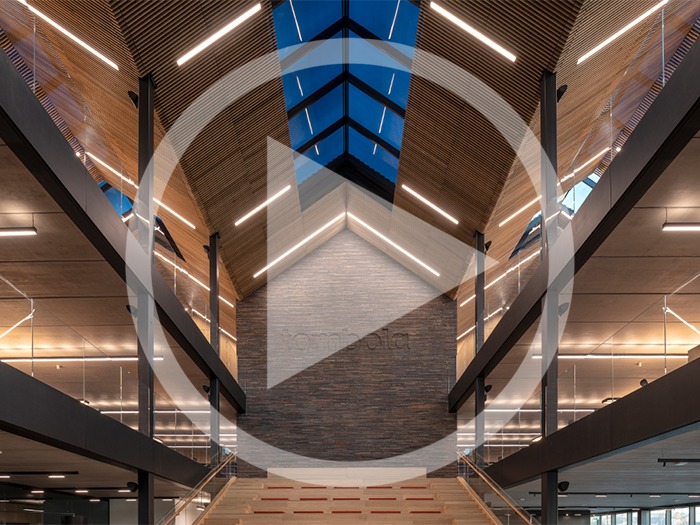
A display of understated elegance, Infinitas by Hacel is a refined LED system. Available in Surface, Suspended or Recessed, in both Bezel and Bezel Free formats, Infinitas is sleek and slender in its design and is precision extruded. The system offers continuous lines of uninterrupted uniform lighting, and the flexibility is further enhanced by uplighting variations and completely illuminated corners. Optional accent luminaires further enhance the versatility of Infinitas. Stylish Solo Modules are available to complement the continuous system.
Casambi appoints new General Manager for North America
(USA) – In a move to reinforce its commitment to the US lighting market and expand operations in the region, Casambi has appointed Mark McClear as General Manager for North America.
McClear is an important figure in the LED and SSL sectors, having previously held a number of high-profile positions, including Vice President Global Sales at Cree, Chief Operating Officer at BIOS Lighting, and having led the LED components business as President of North America for Seoul Semiconductor. He will be based out of Casambi’s North American headquarters in Atlanta, Georgia.
Kari Mettälä, CEO at Casambi Technologies, said: “Mark is a popular leading authority with an unmatched understanding of the smart lighting movement. His unique knowledge gained over decades working at the heart of the industry will undoubtedly accelerate our plans to expand Casambi’s global footprint. Mark will grow Casambi into the leading US wireless lighting control provider.”
McClear added: “Wireless control is the next big leap forward for the lighting industry. Casambi’s open ecosystem architecture is a generation ahead of the proprietary legacy systems currently on the market. Together with the US team, we will provide service and support, and expand Casambi’s commercial network across North America.”
Schnick Schnack Systems LED P-Dot
For special applications like enlightening acrylic rods, or creating hard shadows, there is a need for powerful LEDs. The tiny but powerful LED P-Dot by Schnick Schnack Systems can be comfortably installed with a simple daisy chain wiring system and easily controlled, for example with RGB-video signals. Its four LEDs, red, green, blue and white, have been picked with meticulous discrimination to achieve lighting results of highest quality.
Hacel Solex
The latest generation of compact downlighters, designed and manufactured in the UK by Hacel, the Solex range seamlessly combines outstanding photometric performance, with ease of installation. Delivering lumen outputs up to 5342lm and efficacies of 153lm/W. Solex is available in a wide choice of high quality control gear, including Casambi wireless lighting control. Surface and pendant options complete the Solex range.
John Cullen Lighting Contour Edge
Create clean consistent wall grazing effects with the new Contour Edge from John Cullen Lighting. It combines ultra-low glare with a high 98 CRI to suit your projects whether inside or out. The Contour Edge is available in four sizes – 25, 50, 75 and 100 – which can be easily paired together when a longer illuminated run is required, ensuring that the LED pitch is maintained for a continuous graze.
Corporate Friends C1-mini-C
The new C1-mini-C is one of the smallest Casambi Ready spotlights on the market. With its dimensions of only 42x49x17mm reduced to the absolute minimum it is especially suitable for smallest lighting solutions, where the light source must be discrete without limiting its function. The dimming range has 810 steps, from 100% to 0%, with a minimum non-zero value of 0.4%. Fitted on magnetic track (11x7mm) for 9-24V DC connection, it can be positioned freely in any direction.


